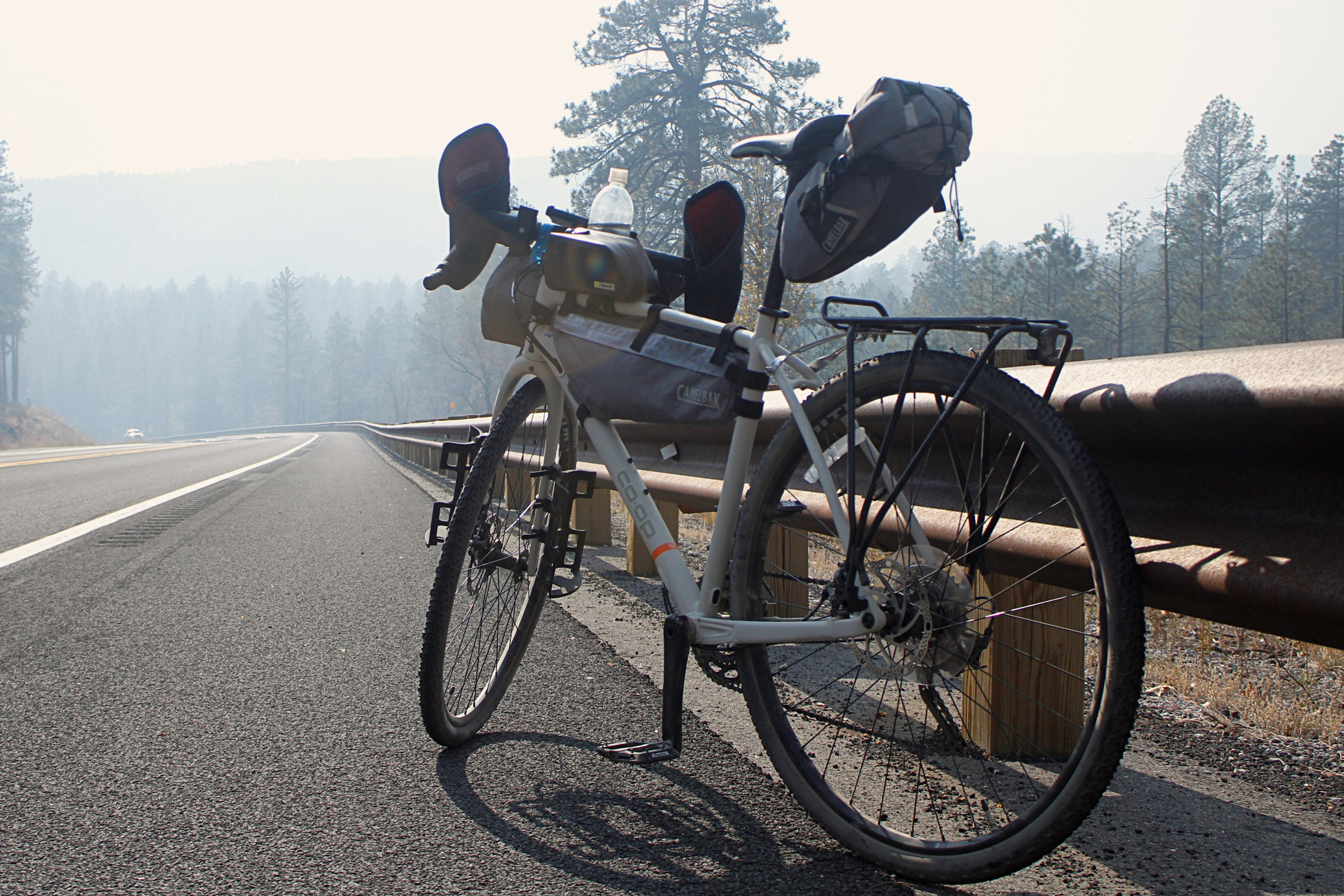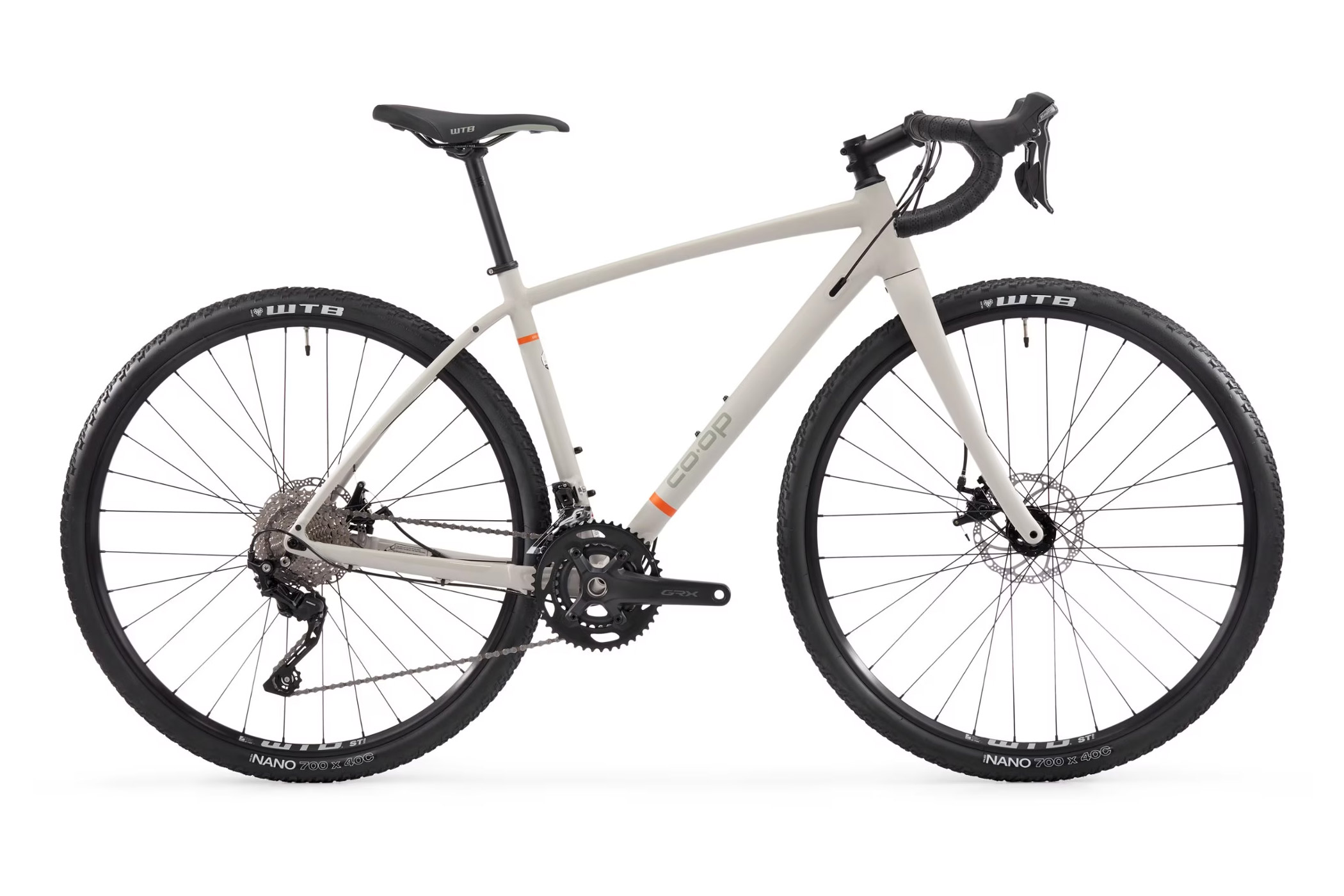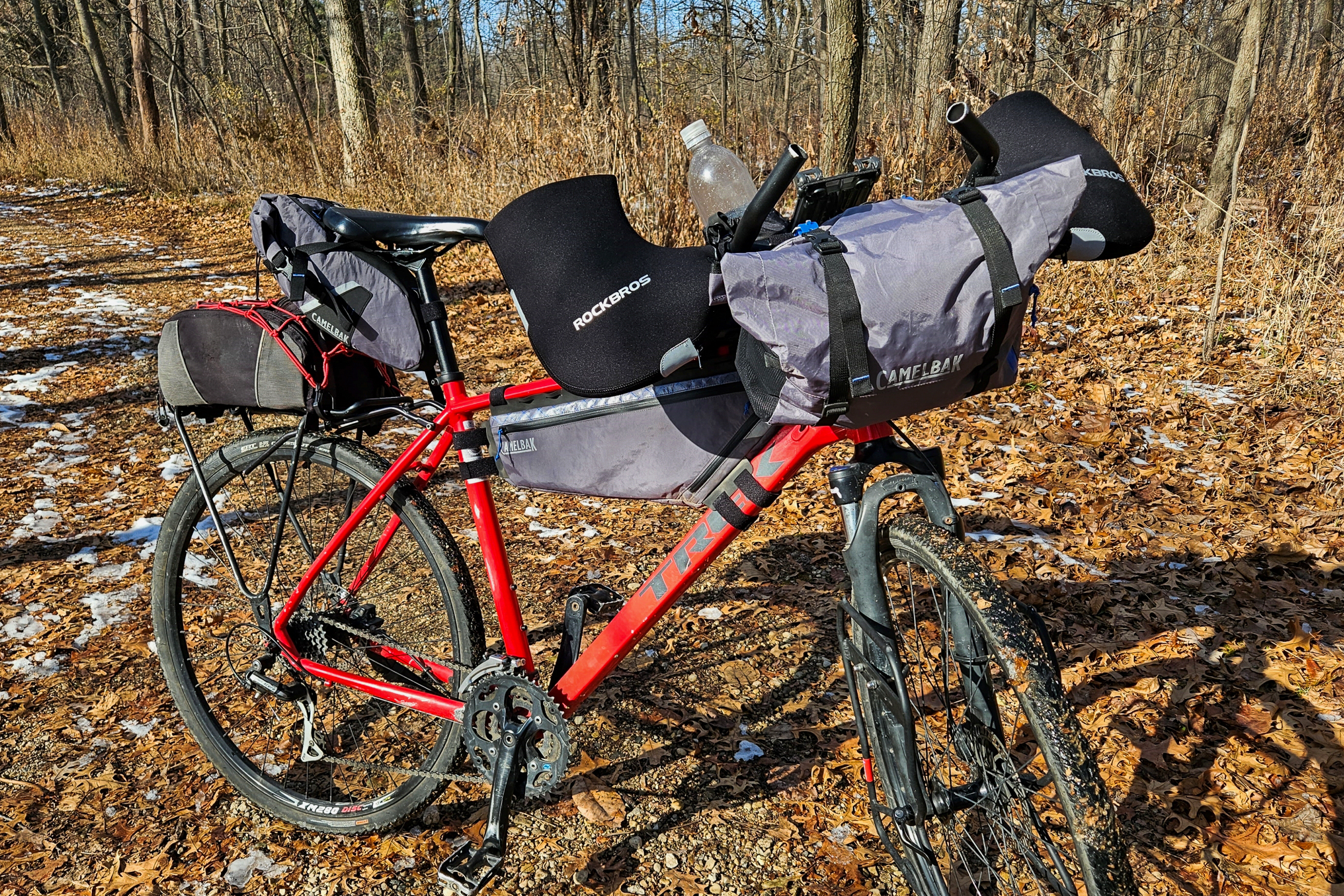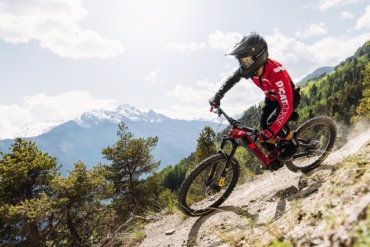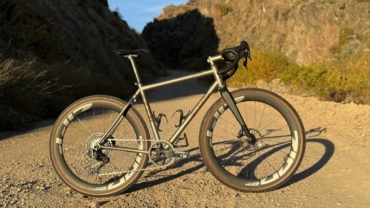“Adventure riding” used to be a term for bikers with throttles and motors, aiming for parts unknown, on and off roads alike. These days, the term is gaining traction in the cycling community, with the same nebulous distinctions that “bikepacking” and “touring” have.
REI builds an intermediate-aimed, aluminum-framed, tubeless-ready gravel bike with interesting attributes. The ADV 2.2 has moderately flared bars, a drivetrain devoted to both grinding gravel and hauling ass, and a quality carbon fork. A generous service plan backs it, but the bike lacks front pannier mounting points or tubeless tires. And REI chose anemic-looking mechanical brakes for it. Finally, the price is hard to beat.
But do these qualities make a bike worthy of the “ADV” monicker?
I rode a 150-mile route that would put the REI ADV 2.2 through a wide-ranging wringer. It included 30 windy miles around the Arizona Snowbowl along fire roads and single track — with 60 pounds of gear. I bombed down the switchbacks of Highway 89A at nearly 40 mph and pedaled from the gravel and dust of Sedona’s desert canyons back up to the alpine. Certainly, this would determine if the REI gravel bike was indeed an “adventure” bike.
In short: REI’s ADV 2.2 truly aims to do it all and does most well for an MSRP of $1,599. It’s an intermediate platform that was stable on singletrack, fast on pavement, slogged a bit on climbs, and can work well for adventurous bikepacking — if you can look past a few things.
- MSRP: $1,599
- Frame: Double-butted 6061 aluminum
- Fork: Carbon; 50-degree offset
- Head tube angle: 71.5 degrees
- Wheels: 700c with WTB Nano 40mm tires
- Wheel clearance: 47mm rear, 43mm front
- Drivetrain: 2×10 Shimano
- Derailleurs: Shimano GRX 400
- Crankset: Shimano GRX 600, 46-30t
- Cassette: Shimano CS-HG50, 11-36t
- Brakes: Tektro MD-C550 cable actuated
- Reach: 394 mm (Large)
- Stack: 571 mm (Large)
- Wheelbase: 1040 (Large)
- Shifters: Shimano Tiagra ST-4700
- Trail: 66 mm
Pros
- Great price
- Carbon fork and relatively stiff frame
- Ample stability
- One year free adjustments and discounted maintenance at 170+ locations
- Trail-capable GRX drivetrain
- Tubeless-ready
Cons
- Weak mechanical brakes
- No front fork mounting points
- Low puncture resistance for stock tires, with inner tubes
- Relatively aggressive drops for bikepacking
Advantages and Disadvantages of REI Co-op Bike Shops
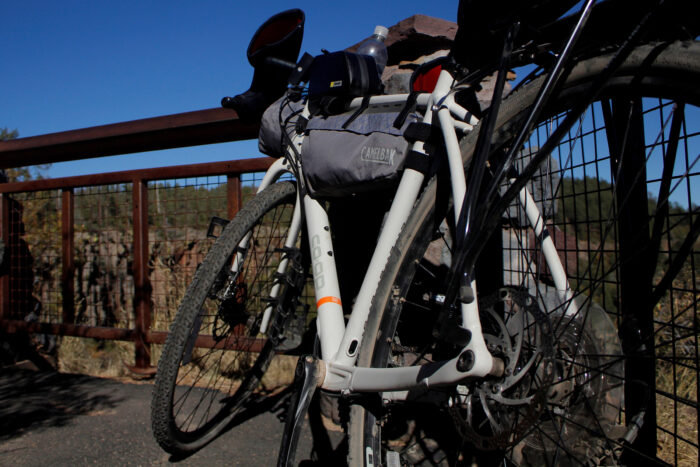
Many consumers consider the bike shop as much as the new bike. It’s hard for some to divorce the purchase from maintenance. REI has over 170 bike shops throughout the country. Given their clientele, many locations are in hotspots for adventure cycling — bikepacking, touring, or mountain bike day trips.
The $1,599 MSRP for the REI ADV 2.2 is no small investment in 2023. However, it comes with 1 year of free adjustments for the derailleurs, brakes, hub, and headset. And includes wheel truing, tire inflation (when you leave the pump in your other, other bag), and chain lubrication. Members also get a 20% discount for other bike shop services.
As someone whose bikepacking trips typically revolve around hopping on Amtrak, hoping that rocking around in a cargo hold doesn’t snap a derailleur hanger, and swinging by a nearby outfitter for something I inevitably forgot — it’s assuring to know that last-minute adjustments are under warranty and widely accessible.
There’s at least one negative to buying from a nationwide co-op that more heavily serves backpackers and campers. The REI ADV 2.2 comes with inner tubes, despite being tubeless-ready. REI also decided against threaded bosses on the fork, and notably, the stores offer few, if any, front racks.
Around-Town First Impressions
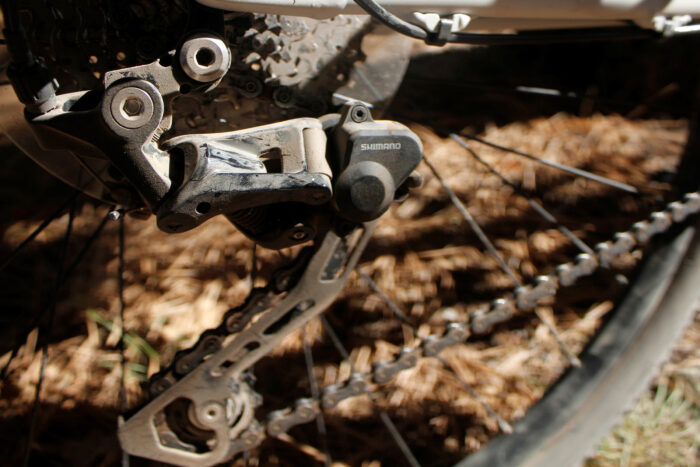
I picked up the REI ADV 2.2 in Flagstaff and had an evening to kill before my significant other landed. I quickly found myself in high gear around town, feeling nimble, flying along the shoulders of Route 66 at 25 mph. However, I wondered if the gearing would leave me walking up some of the steepest slopes the next day.
The Shimano GRX 400 derailleurs delivered quick and reliable shifting. The relatively slack head tube angle made it easy to ride no hands, even with a duffel on my back. Riding on the hoods at speed felt fine, but the drops felt too aggressive for anything other than the tarmac.
Climbing and Descending on the REI ADV 2.2
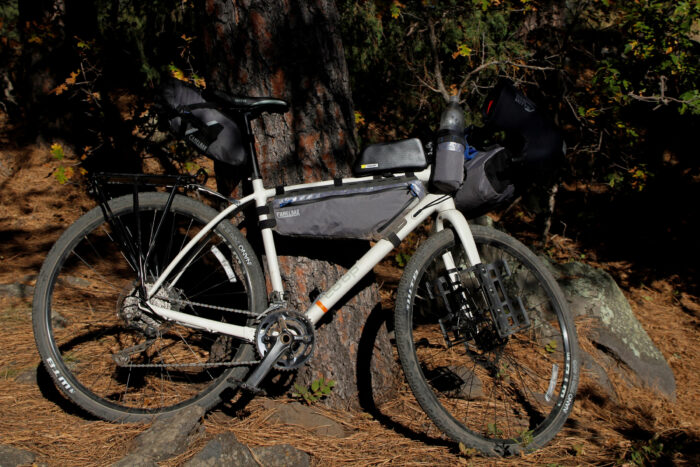
I apologized to the bike the next day, as I loaded up 60+ pounds of gear for two. Between gear and body weight, I was within 30-35 pounds of the bike’s 300-pound limit. I felt the frame that was stiff while cruising around town the day before flexing through the first turns on the trail.
This was exacerbated by the lack of front fork mounting points. I believe that any rigid fork “adventure bike” should include front mounts. All the more so when its native shop doesn’t carry many universal racks or cages.
An old Topeak Versacage let me run dry bags on either side, but I was still a bit rear-heavy. For anyone looking to outfit the bike in a way that complements its versatility, I recommend the Old Man Mountain Elkhorn up front.
I found myself closely minding my shifting on sharp down-to-up transitions and gravelly, baseball boulder-strewn curves. On steep climbs, the lowest gear felt a bit too intense.
My body also informed me that the hoods created a position that was too aggressive for climbing with a small backpack. Still, only the steepest sandy uphill banks and boulder-strewn climbs forced me off the bike.
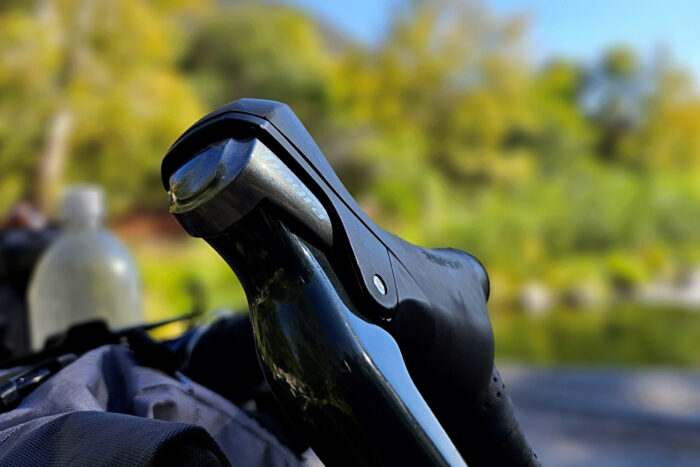
Downhill, the REI ADV 2.2 was a joy. The high gearing hauled wholesale while the rear derailleur clutch prevented chain slap. The 40mm-wide tires deflected the occasional baseball boulder. The frame flexed as I had turned it into a high-speed armored personnel carrier. But the moderate geometry, wheelbase, and comfortable Tiagra hoods had me bombing through 30 mph winds with a stupid grin.
The only thing that occasionally wiped that grin off my face was the Tektro mechanical disc brakes. But the real test would come with the next section of my ride.
Switchback Speed
The REI ADV 2.2 is a genuine attempt at a do-it-all bike. The next section was a paved road that would stress test its high-speed, low-drag chops. Unloading all but 10-15 pounds of gear and water, I opted to race from Flagstaff to Sedona down Highway 89A. The main challenge: bombing switchbacks steep enough to get to twice the speed limit — if doing so wouldn’t send me flying off a cliff.
With a controlled burn nearby, I set off through midmorning smokescreen, experimenting with the rear derailleur clutch on and off over the first 14 miles of rolling hills. I wanted to see if the chain or derailleur jumped when I stopped pedaling on high-speed downhills with the rear derailleur clutch disengaged.
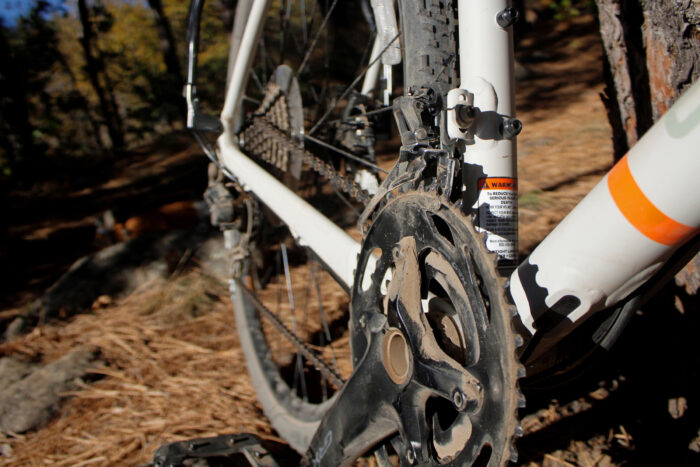
The shifting was lighter sans clutch, but the drivetrain was smooth with it on or off. On the rough gravel downhills days before, the drops felt almost aspirational. Slightly aggressive, with only a 12-degree flare, they felt like roadie-leaning compromise. To wit, on asphalt, they were a joy to ride downhill and felt athletic on flat ground.
No longer rear-heavy and carrying 60 pounds of gear, the REI ADV 2.2’s frame felt comfortably stiff as I bombed down the switchbacks. With ample trail and gravel tires, the bike wasn’t snappy, but it was nimble enough to hug the curves.
The Tektro mechanical disc brakes caused white-knuckling, though. Racing down the mountain on gravel, I was pushing 285 pounds, and the brakes performed as expected. On pavement north of 35 mph, I wished for substantially more braking power and responsiveness on every cliffside curve.
Desert Dilemmas on the REI ADV 2.2
The last test of the journey would be slow and steady. One more fully loaded ride, this time a gradual 40-odd-mile ascent up a half-mile of vertical gain. I traveled along fire access roads starting in the desert and ending in alpine country.
But I noticed a cactus spine sticking out of the rear tire. The ADV 2.2 does rock tubeless-ready rims and wheels. I stuck with inner tubers to test it in the configuration that the customer would receive. Then I noticed that my pump was missing.
As I borrowed a pump at a campsite, the lendee took an interest in the bike, asking, “So this is REI’s main mid-level gravel bike? Cool! Why does it have mechanical brakes?” Then I noticed the unrepairable hole in my front inner tube.
Then I noticed that the extra inner tube I asked my significant other to pack did not have a Presta valve.
Be smarter than me. If you get the REI ADV 2.2, run it tubeless. The WTB Nano Comp tires were a joy over road and gravel but offered little puncture resistance.
I hitchhiked back to a shop in town. Be. Smarter. Than. Me.
The Road Uphill
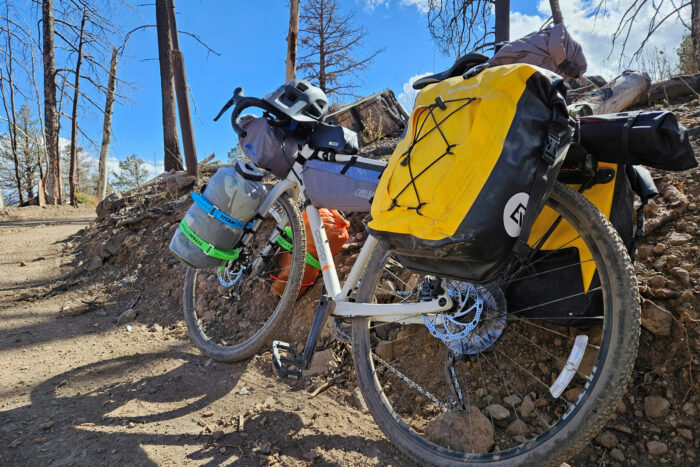
Waylayed by repairs, I opted for the quicker, sketchier ride back up 89A. Uphill, on a weekend, this meant skinny shoulders, high traffic, and a light-as-lead slog up the switchback slopes.
Fortunately, the bike’s natural stability made hugging the 2-inch margin I had between the guardrail and my side-mounted bags surprisingly easy. Nearing the steepest section, I disengaged the rear derailleur clutch, and the shifting action lightened.
While the lowest gear still felt a touch high, not once did I have to abandon it during the hour-long trudge up the switchbacks. I did, however, find myself pedaling firmly in the saddle. Rear-weighted once more, standing meant too much frame flex, too close to cliffs.
And yet, at the end of a stressful, unexpectedly time-constrained day of nonstop climbing, I found myself happy that I had the REI ADV 2.2 to carry me to the top.
REI ADV 2.2: Adventurous Conclusions
“Adventure” and “gravel” are hot words. They overlap, but they aren’t one and the same. To my mind, a gravel bike is usually a drop-bar hybrid, capable of handling a wide array of terrains, from downtown to moderate single track. The promise of an adventure bike is the capability to haul a week’s worth of gear through parts unknown-ish.
So, where does REI’s flagship, do-it-all bike stand?
The drivetrain was just low enough for bikepacking, and plenty high for speedy road riding. For 2x newbies, the double chainrings had a bit of a learning curve, but the Shimano GRX derailleurs took a beating.
Despite a history of wrist injuries and some long stretches up and downhill, the Shimano Tiagra hoods were never uncomfortable. The drops were a blast on roads but lacked the flare I’d want for navigating tricky trails.
The stock tires deflected on relatively large rocks, but performed well in a wide array of terrain. They couldn’t protect against prickly pear spines, but they are tubeless-compatible.
With a light loadout, the bike nimbly bombed down switchbacks and raced down gravel with stability. However, heavily loaded climbs caused moderate, doberman-with-a-docked-tail-level wagging. With better weight distribution, this would be reduced, but the lack of front mounting points makes life harder for cyclists gearing up for their first big “adventure ride.”
Overall, off the rack, the REI ADV 2.2 is a gravel-eating machine, backed by great service, and plenty capable of hauling riders wherever they need to go. For more ambitious rides, with more weight, on longer trails — a few tweaks would take it from adventure-adequate to adventure expert.
These modifications include converting to tubeless, throwing a rack up front, maybe upsizing to wider tires, and either getting adept with the stock mechanical brakes or swapping to hydraulic. Ultimately, whether ambling along rail trails or getting lost on remote routes, the REI ADV 2.2 will make it a fun ride.
